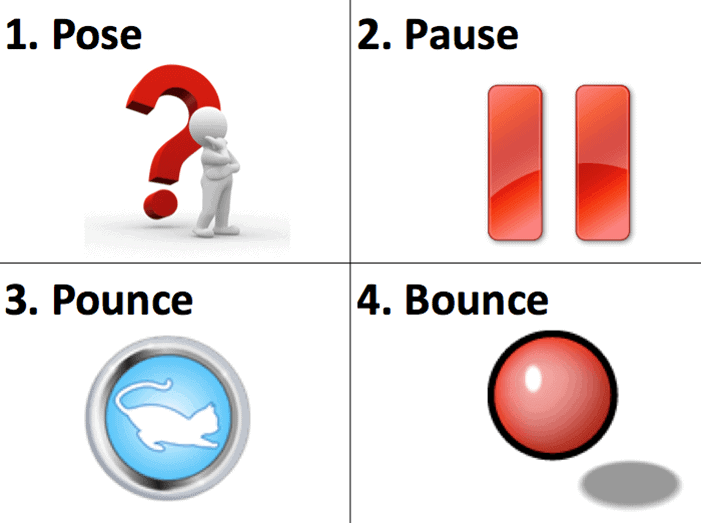
I recently found this fantastic effective questioning resource by Ross McGill (of Teacher Toolkit) that I felt was worth blogging about. I have been using this resource within my lessons recently and it has really helped add to the variety and range of questioning techniques I use to try and engage all learners in questioning, acting as an AFL tool and active questioning strategy. So here it is, try it for yourself and let us know how you get on!

Pose, Pause, Pounce, Bounce (PPPB)
PPPB is a simple, yet sophisticated, AfL (Assessment for Learning) questioning technique to help teachers move from ‘good’ to ‘outstanding’.
It also helps address differentiation in the classroom and encourages teachers to slow down, take risks and tease out understanding. It helps to engage all learners in questioning and can be used as an active questioning tool (no hands up approach to questions).[clear]

1. Pose

a) Give the context of your PPPB approach to the class. It is important they know what is happening before it becomes common-place…
b) Insist on hands down before the question is delivered.
c) Provide a question or a series of questions, ensuring that you ask the students to remain reflective.
d) Pose the question to the class; not an individual.
Then Pause…
2. Pause

a) This is the difficult part. To stop talking…
b) Ask the class to hold the thought… think… and think again…
c) If students are captivated and engaged, try holding the silence for a little while longer (take a calculate risk) and…
d) Still push the boundaries. Keep the reflection for as long as possible….before you…
e) Pounce!
3. Pounce

a) Insist that the answer to the question comes from student A and possibly student B, directly and as fast as possible!
b) Of course plan in your mind who you are going to ask, before speaking to the class.
c) Name student A to respond and don’t move from the student…
d) Possibly don’t speak and nip any comments, grunts or noises in the bud! Its magic when you can hear, see and feel a captivated learning audience. We’ve all seen it.
e) Wait for an answer… pause… decipher the support needed, especially if no response is evidently on its way. (Of course, at this stage, you can instigate various strategies for peers to support the questionable student A).
f) If student A does manage to answer, the fun part starts here…
4. Bounce

a) Ask another student B their opinion of student A’s answer (immediately) after the Pounce response.
b) This can be developed by asking student B and C their opinions to student A’s response, irrespective if the answer is correct or not.
c) An additional strategy is to Bounce the question onto a group A… and subsequently, a sub-group B if group A do not deliver a suitable way forward.
d) This ensures the teacher is engaging a significant number of students with the question at hand, whilst using this strategy. It also ensures the entire class can be called upon at any given time by just returning to Pose or Pounce.
e) Many, many teachers are very reluctant to hold onto a question that is a stumbling block in class. I know because I have done it; but my favourite lessons are often the ones that involve this ethos being established from the outset and (me) not being afraid to tease out “why?” student A or B thinks the way they do…
f) Ensure that all your students understand ‘a’ concept. Test it before moving on. Try it tomorrow. Don’t accept student E or student K shouting out the answer to maintain pace or behaviour. Don’t allow student T to answer the question because (you know they won’t let you down and) they will help you move on during an observation lesson!
Summary
Teasing out students’ thinking skills and understanding is far more important than moving onto the next stage of any lesson. If you use similar or different questioning methods please let us know by commenting below – we would be interested in hearing new ideas and sharing best practice.
For more information about this resource, please download the attached PowerPoint presentation below.


Love this idea can’t wait to try it out
[…] https://www.pescholar.com/blog/2576/effective-questioning-idea/ […]
Post updated. A big thankyou to Ross McGill (@TeacherToolkit) for allowing us to republish this fantastic effective questioning idea.
Original resource is here – which is fantastic – I must say!
http://www.tes.co.uk/teaching-resource/Pose-Pause-Pounce-Bounce-by-TeacherToolkit-6242203/
I came across this on Twitter and have found it fantastic in class. When you bounce, you can insist on students giving an “ABC” response – where they either Agree, Build on, or Challenge, the previous response – Twitter again. Then there’s Think Pair, Share, as another way of getting students doing the thinking – you ask your question, they think about it individually, then discuss with their partner, then each pair could discuss with another pair before you then seek responses from them. Gets all students engaging with the topic – triffic!
Thank you
Works brilliantly with all levels of learner-
Love this idea, Im big on trying out the questioning techniques with my A Level and I tweak a lot of OCR marks schemes to incorporate effective questioning and ways of reviewing their learning as well as exam practice. Ill pop my tasks up on here or share them on @PE4Learning twitter account. I get way to exited over all of this sharing or resources business – a definite PE Geek!
[…] http://www.fromgoodtooutstanding.com/2012/05/ofsted-2012-questioning-to-promote-learning http://learningspy.co.uk/2012/02/04/how-effective-learning-hinges-on-good-questioning/ http://www.tes.co.uk/teaching-resource/Pose-Pause-Pounce-Bounce-by-TeacherToolkit-PPPB-6242203/ […]
This sounds awesome! Will definitely give it a try!
I will need to try this technique. This would have been great for a lesson I taught a couple of weeks ago.
[…] https://www.pescholar.com/blog/2576/effective-questioning-idea/ […]